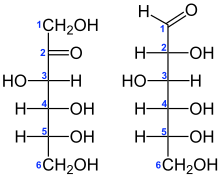
High-fructose corn syrup (HFCS), also known as glucose–fructose, isoglucose and glucose–fructose syrup,[1][2] is a sweetener made from corn starch. As in the production of conventional corn syrup, the starch is broken down into glucose by enzymes. To make HFCS, the corn syrup is further processed by D-xylose isomerase to convert some of its glucose into fructose. HFCS was first marketed in the early 1970s by the Clinton Corn Processing Company, together with the Japanese Agency of Industrial Science and Technology, where the enzyme was discovered in 1965.[3]: 5
As a sweetener, HFCS is often compared to granulated sugar, but manufacturing advantages of HFCS over sugar include that it is cheaper.[4] "HFCS 42" and "HFCS 55" refer to dry weight fructose compositions of 42% and 55% respectively, the rest being glucose.[5] HFCS 42 is mainly used for processed foods and breakfast cereals, whereas HFCS 55 is used mostly for production of soft drinks.[5]
The United States Food and Drug Administration (FDA) states that it is not aware of evidence showing that HFCS is less safe than traditional sweeteners such as sucrose and honey.[5] Uses and exports of HFCS from American producers have grown steadily during the early 21st century.[6]
- ^ European Starch Association (10 June 2013). "Factsheet on Glucose Fructose Syrups and Isoglucose".
- ^ "Glucose-fructose syrup: How is it produced?". European Food Information Council (EUFIC). Archived from the original on 17 May 2017. Retrieved 9 February 2024.
- ^ Cite error: The named reference
WhiteChapter2014was invoked but never defined (see the help page). - ^ Cite error: The named reference
white09was invoked but never defined (see the help page). - ^ a b c "High Fructose Corn Syrup: Questions and Answers". US Food and Drug Administration. 4 January 2018. Retrieved 19 August 2019.
- ^ Cite error: The named reference
faswas invoked but never defined (see the help page).